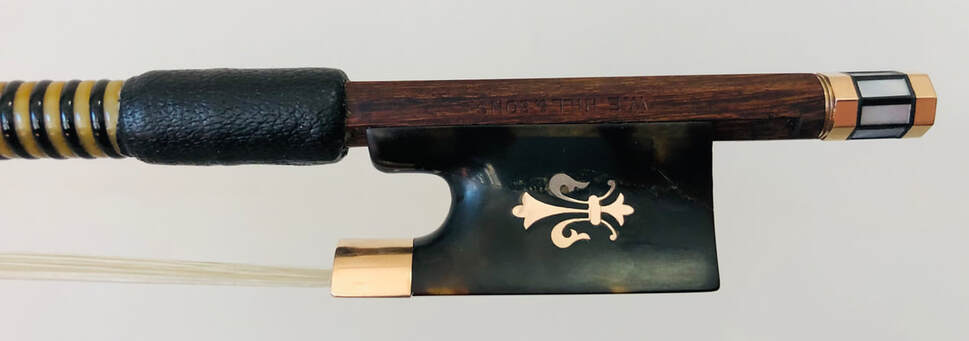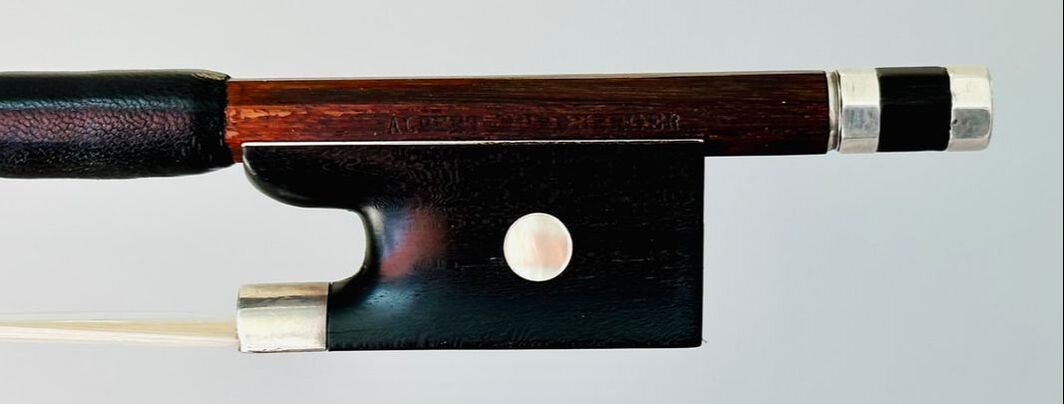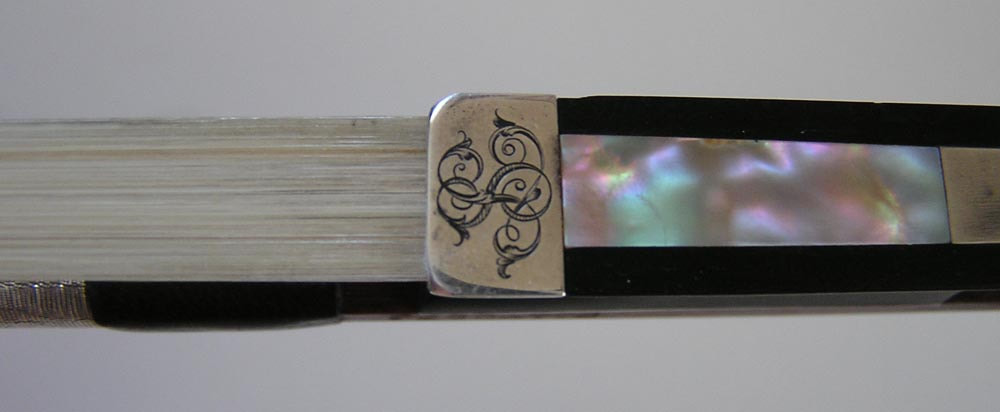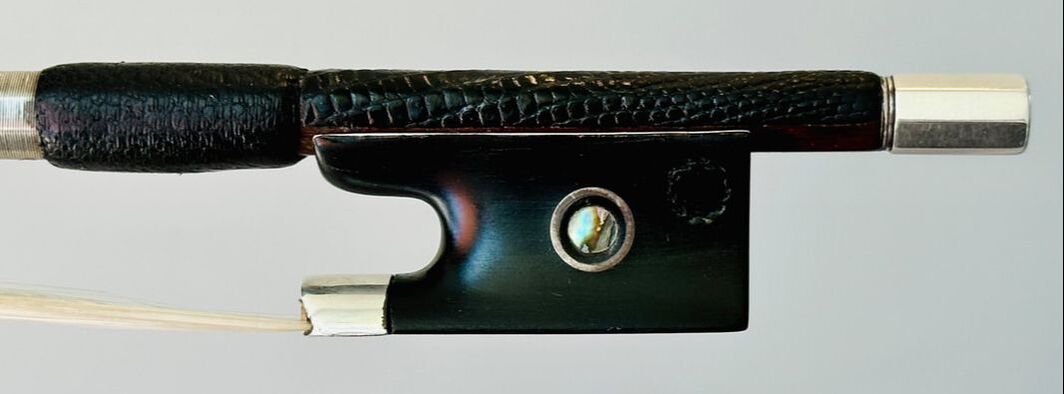Bows
We carry a wide selection of violin, viola, and cello bows from the student to professional level.
For professionals and collectors, we carry fine examples by makers such as Peccatte, Sartory, Maline, Voirin, Vigneron, Tubbs, Nürnberger, W. E. Hill & Sons, Morizot, Bazin, Pfretzschner, and many more...
We are also carry many bows of exceptional quality by lesser-known makers.
Our bow inventory changes frequently. This is only a partial list. Please contact store for details.
For professionals and collectors, we carry fine examples by makers such as Peccatte, Sartory, Maline, Voirin, Vigneron, Tubbs, Nürnberger, W. E. Hill & Sons, Morizot, Bazin, Pfretzschner, and many more...
We are also carry many bows of exceptional quality by lesser-known makers.
Our bow inventory changes frequently. This is only a partial list. Please contact store for details.
Pictured: Gold and Tortoiseshell 'Fleur de Lys' violin bow by W.E. Hill & Sons
Features From Our Current Bow Collection
|
Violin Bow by: W.E. Hill & Sons 'Fleur de Lys", London c.1960
Featured Bow ($10,000 - $20,000) The 'Fleur de Lys' bows were intended to represent the highest quality bows produced by the prestigious English firm of W.E. Hill & Sons. Indeed, virtually all of England’s greatest bowmakers had, from the 1860’s onward, produced bows for them. They were favorites of violin virtuoso and composer, Fritz Kreisler (who had a good selection from other makers as well). This gold and tortoise shell mounted 'Fleur de Lys' bow is by Malcom Taylor (b.1933-d.2012). Precious materials such as gold, ivory and tortoise shell were reserved for their finest sticks. Today bowmakers typically no longer use endangered animals in the production of fine bows yet the modernity of this example serves as a reminder that it is only in the last few generations that we have become aware of our responsibility as global stewards. This bow, made sometime between 1956 and 1965, produces a broad and powerful sound and would be best suited for a strong and bold player or a private collection of fine bows. Weight: 62.1 grams Available Now |
|
Violin Bow by: Charles Louis Bazin, Mirecourt c.1930
Featured Bow ($10,000 - $20,000) Charles Louis Bazin (b. 1881, d.1953), having begun working in his father's shop from the age of 12, he consistently produced bows of very fine quality and are used extensively by professions throughout the world. Some of the best work from this great French maker are his copies of the English master, James Tubbs. This elegant bow provides great feedback to the player. It is supple and best suits a violin which is sensitive to the bow. Paul Childs said this was perhaps the finest bow by this maker he's ever seen. Sold with Paul Childs Certificate Weight: 60.5 grams Available Now |
|
Violin Bow Probably by: John Dodd I c.1840
Featured Bow ($5,000 - $10,000) John Dodd I (b.1752, d.1839) led the transition away from classical bows into the modern bow we know today. He is considered one of the two most important English bowmakers. His work virtually always utilizes the very finest pernambuco. If his work can be criticized at all, it is only because poverty precluded him at times from realizing his ideal conceptions. As with many early-modern bows, this example has at least one replacement part, that being the cap of the adjuster. Still, it has a superb stick with excellent strength, contact, tone and projection. Like most Dodds, it is a few millimeters shy of today's standard bow length. This bow is certainly an early-modern English bow with all the hallmarks of a Dodd bow. Still, we are stopping short of declaring with absolute certainty that this is the personal work of Dodd. It is therefore priced accordingly. Weight: 60.5 grams Available Now |
|
Violin Bow by: Franz Albert Nürnberger II, Markneukirchen, c.1920
Featured Bow ($5,000 - $10,000) Franz Albert Nürnberger Jr. (b.1854, d.1931) was one of the finest and most important German bow makers. His shop produced large numbers of supremely high-quality bows. In the early half of the 20th century, there was very little difference in price between a good Nurnberger and a Sartory. The Nürnberger family is the longest continuous line of bowmakers in history. Franz Albert Jr. and his son, Carl Albert, are considered the two best makers of the family and focused primarily on Tourte models although superb copies of various makers appear. Fritz Kreisler, Eugène Ysaÿe, Erika Morini and David Oistrakh all performed with Nürnberger bows. This bow is from the best period. It draws a big and crisp tone great for articulation and texture. Weight: 60 grams Available Now |
|
Violin Bow by: Rudolf Neudörfer
Featured Bow ($3,500-$5,000) Rudolf Neudörfer (b.1945), a fourth-generation violinmaker, grew up in socialist, post-war Czechoslovakia and further studied violinmaking under Bohumil Pechar and Hans Schmirler at the Violin Making School in Luby. As a skilled maker, he was prevented from emigrating and worked building the first 'Master' violins for the Cremona company. In 1968 he escaped Czechoslovakia by posing as a ski coach at the Olympic Games in Innsbruck. Having then apprenticed as a bow maker, he went to work for the Finkel shop in Switzerland and eventually opened independently. His work took him to Tokyo, Brazil and many other places and was eventually contracted to work for the former Hans Weisshaar shop in Hollywood. Neudörfer's work has won awards at the Violin Society of America and the National Bow Making Competitions in Wiesbaden. This bow tracks perfectly across all strings producing a strong, beautiful and complex tone. Weight 59.8 grams Available Now |
|
Violin Bow by: Rudolf Neudörfer
Featured Bow (under $3,500) Rudolf Neudörfer (b.1945), a fourth-generation violinmaker, grew up in socialist, post-war Czechoslovakia and further studied violinmaking under Bohumil Pechar and Hans Schmirler at the Violin Making School in Luby. As a skilled maker, he was prevented from emigrating and worked building the first 'Master' violins for the Cremona company. In 1968 he escaped Czechoslovakia by posing as a ski coach at the Olympic Games in Innsbruck. Having then apprenticed as a bow maker, he went to work for the Finkel shop in Switzerland and eventually opened independently. His work took him to Tokyo, Brazil and many other places and was eventually contracted to work for the former Hans Weisshaar shop in Hollywood. Neudörfer's work has won awards at the Violin Society of America and the National Bow Making Competitions in Wiesbaden. This bow was owned by an L.A. based professional violinist for many years. Nickel Silver Weight 58.8 grams Available Now |
Recently Sold Bows
|
Violin Bow by: Eugène Sartory, Paris c. 1920
Featured Bow ($20,000 & Up) Eugène Sartory (b.1871, d.1946) is generally considered the most important bowmaker of the 20th century. He set up his own shop at 18 years of age and went on to employ legendary makers such as Jules Fétique and Louis Morizot (among others) as his assistance, finishing off each bow and making sure that they met his meticulous standards of approval. His models take their inspiration largely from Voirin and Lamy but Sartory introduced elements which infused the elegant designs of his predecessors with increased strength, allowing the player to drive the bow harder. Eugène Ysaÿe was one of Sartory's biggest advocates. Sartory bows have also found their way into the hands of countless orchestra players and virtually every important collection. They continue to remain in the highest demand today. This example dates to the maker's best period and has spent the last many years paired with an 18th century Italian masterpiece of violinmaking. Sold with Paul Childs Certificate Weight: 61.2 grams |
|
Violin Bow by: François Nicolas Voirin, Paris c.1875
François Nicolas Voirin (b.1833, d.1885) was probably the finest and most important bowmaker of his era. He bridged the gap between the robust form of the Peccatte school and the subtler form of Vuillaume school. Voirin was in fact a cousin of J.B. Vuillaume and worked in the Vuillaume shop from about 1855 to 1870 where he made many of the “picture bows” which included a microfilm image (generally of Vuillaume) visible through a stanhope lens in the frog. Voirin was influenced largely by Pierre Simon, who had worked first for Dominique Peccatte and later for Vuillaume. This example was made at the beginning of Voirin’s final and best period, shortly after he established independently in 1870. Historically, bows by Voirin have been most perhaps the most favored among the great violin soloists since the late 19th century. Famous Voirin players include Eugène Ysaÿe, Mischa Elman, Isaac Stern, Pinchas Zukerman, Stefan Jackiw and many others. One of Yehudi Menuhin’s two favorite bows throughout his life was a Voirin from the same period as this example. This example is strong yet highly responsive and uniquely capable of translating subtle impulses. The Voirin is sublimely balanced and draws a smooth and lush tone. It is immediately responsive, nimble, articulate and seems to follow the bow hand automatically as if it were a natural extension of the body. It is extremely versatile both in relation to the repertoire and to the violin which it is paired with. In the right hands, it is capable of drawing the full potential from the instrument. It is, in the opinion of our shop, among of the finest playing bows we have ever handled. Sold with Raffin Certificate. Weight: 59.5 grams |
|
Charles Peccatte, Paris c.1900
Charles Peccatte (b.1850, d.1918) was the son of Francois Peccatte. His uncle was the Dominique Peccatte, (considered one of the finest and certainly most influential bow maker after Tourte). Charles Peccatte worked for J.B. Vuillaume and was under the legendary François Nicolas Voirin. His models tend to be somewhat more masculine than Voirin's. Both he and Joseph Alfred Lamy employed Eugène Sartory and in many ways, can be considered a bridge between these figureheads of French bowmaling. This example has a beautifully engraved ferrule |
|
Violin Bow by: James Tubbs, London c.1900
Inarguably the greatest of the English bow makers, James Tubbs is sometimes referred to as the 'English Tourte'. Tubbs was appointed bowmaker to the Duke of Edenborough. He was hugely prolific but most of his work was done to make ends meet and is too soft for many players today. His best work however, ranks among the finest bows ever made. |
|
Violin Bow by: Franz Chalupetzky, Germany c. 1960
Though not an especially famous name in bowmaking, Franz Chalupetzky bows are of consistently high quality in terms of materials and workmanship. This bow is a favorite in its class for its wonderful tone and playing characteristics. It is very attractive with its decorated motifs in the fittings as well as the fleur de lys set into the dark tortoise shell frog. This is simply a great "player's bow". Weight: 62.9 grams |
|
Violin Bow by: Hermann Richard Pfretzschner, Markneukirchen, c.1910
Featured Bow ($3,500 - $5,000) HR Pfretzschner (b.1857, d.1921) was another of the finest and most important German bow makers. Having trained in bowmaking under his father, HR Pfretzschner, went to work for the legendary shop of J.B. Vuillaume in Paris, 1874. He spent only one year there however the experience left an indelible impression on him. Afterward, he made extremely faithful copies of Voirin, whose work he was intimately acquainted with in Paris, as well as bows modeled on Tourte and the Vuillaume style. From 1880, he established independently in Markneukirchen and made bows for some of the greatest virtuosi of his day. In 1901 he was appointed "Purveyor to the King of Saxony" and supplied bows to the royal court, symphony orchestra and conservatory in Dresden. From that time, is bows are embossed on the frog with the Saxon coat of arms. This example is very strong and favors a bold approach, ideal for big concerti. Nickel Silver / Weight: 64.4 grams Sold |
|
Violin Bow by: Otto Dölling, Markneukirchen, c.1930
Featured Bow ($5,000 - $10,000) Another great German "player's bow" from a maker whose work is largely overlooked today. This bow is firm yet responsive. It produces a nice tone and has crisp articulation. It would suit a player looking for both strength and dexterity. Weight: 61.8 grams (with additional lizard skin) Available Now |




























